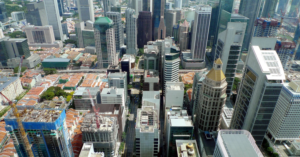
Introduction
The real estate sector in Vietnam is taking centre stage in Asia’s investment landscape. According to the latest report by JLL, titled “Vietnam Property Market Outlook 2025: A New Chapter in Economic Growth,” crowding in investor sentiment, expanding infrastructure, and favourable policy changes are driving momentum across major asset categories.
Macroeconomic & Investment Drivers
In 2024, foreign direct investment (FDI) in Vietnam reached US$25.4 billion, up 9.4% year-on-year. This influx of capital is underpinned by a young, dynamic workforce, improving infrastructure, and an increasingly sophisticated investor base. Lower borrowing costs and rising investor confidence are now opening the door to increased transaction activity.
Segment-by-Segment: What’s Hot
- Office Market: In Ho Chi Minh City, net absorption of Grade A office space topped 43,000 m² in 2024, signalling revived demand for premium workspace. Tenants are increasingly demanding green-certified, well-located offices tied to productivity and sustainability.
- Residential Market: After a lull in supply, regulatory amendments enhancing transparency and simplifying project approvals are paving the way for residential sector growth, especially in Hạ Nội, HCM City, and surrounding satellite zones.
- Industrial & Logistics: Vietnam’s strategic role in the global supply chain, buoyed by the “China +1” manufacturing shift, is turbo-charging its industrial real-estate segment. Infrastructure upgrades and policy support are attracting significant investment in manufacturing and logistics estates.
Why Vietnam Stands Out in Asia
- Demographic Tailwinds: A young, urbanising population drives demand for housing, retail, and modern office space.
- Policy & Reform: Enhanced transparency, improved project-approval processes, and investor-friendly signals boost confidence.
- Strategic Location: Positioned at the heart of Southeast Asia, Vietnam offers access to regional trade flows, manufacturing relocation, and supply-chain diversification.
- Infrastructure Momentum: Major projects—from metro lines to logistics hubs—are reshaping connectivity and unlocking new property-market catchments.
Risks & Considerations
Of course, no market is without risks. Prospective investors should factor in:
- The timing and effective implementation of reforms and regulatory changes.
- Potential oversupply in certain sub-markets, particularly if demand fails to track projections.
- Currency, interest rates, and global macro-shocks can disproportionately impact emerging-market real estate.
- Sustainability and ESG pressures, especially as tenant expectations evolve and green certification becomes more of a must-have rather than a nice-to-have.
Outlook & Strategy for Investors
Looking ahead to 2025, JLL anticipates a significant uptick in deal flows across all key asset classes in Vietnam’s real-estate market. For investors seeking exposure in Asia’s next-wave property markets, Vietnam offers a compelling mix of growth, diversification, and momentum.
Recommended approaches include:
- Core + repositioning of prime office assets in HCM City’s CBD, tapping stronger tenant demand and rising rents.
- Residential developments in rapidly expanding satellite zones, where supply is catching up to growing demand.
- Logistics/industrial parks targeting export-oriented manufacturing and last-mile distribution, aligned with the global supply-chain shift.
Conclusion
Vietnam is no longer just an emerging-market real-estate story—it is emerging as one of Asia’s most attractive property markets. With favourable demographics, infrastructure push, policy reforms, and investor confidence all converging, the country is poised for accelerated property growth. For investors, market watchers, and real estate professionals, Vietnam deserves a spot on the radar.
Discover more about real estate news and promotions at propertynewsasia.com.








